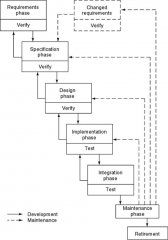![]()
![]()
![]()
Use LEFT and RIGHT arrow keys to navigate between flashcards;
Use UP and DOWN arrow keys to flip the card;
H to show hint;
A reads text to speech;
20 Cards in this Set
- Front
- Back
|
What is stepwise refinement?
|
Prioritize the tasks
Concentrate on the most important Postpone those of lesser importance Repeat until done All task receive attention, according to importance The process is both incremental and iterative |
|
|
Miller’s Law
|
At any one time, people can deal with only 7 units of information (tasks)
|
|
|
Robustness
|
Able to absorb extension and change without collapsing
An architecture that survives the incremental and iterative process is robust Robustness is an essential property during maintenance |
|
|
Strengths of Increment and Iterate
|
Multiple opportunity for evaluation
Resulting architecture is robust Always have a working version Enhanced opportunity for risk mitigation |
|
|
What are the characteristics of The Rational Unified Process?
|
Use-case driven
Architecture centric A specialization of iterative-incremental Described by an orthogonal set of phases and workflows |
|
|
What are the 4 phases of The Rational Unified Process?
|
Inception (to develop a sound business basis for the system)
Elaboration (Refine the initial requirements, Refine the architecture, Monitor the risks and refine their priorities) Construction (Programming and implementation with integral testing activities) Transition (Move the system from the development environment to its real environment) |
|
|
What is a workflow?
|
Describe the tasks or activities that a developer performs to evolve a system
|
|
|
What are the two categories of workflows?
|
Engineering
Support |
|
|
What is an Engineering workflow?
|
Technical activities
|
|
|
What is a Support workflow?
|
Managerial activities
|
|
|
What are the 7 engineering workflows?
|
Business Modeling (Ensure that the system will support the business goals) - Inception
Requirements (To determine the users needs by eliciting functional, nonfunctional and pseudo-requirements) - Elaboration Analysis (Refine and specify the requirements more precisely) - Elaboration Design (Defines the internal structure of the system) - Elaboration/Construction Implementation (Implement the design in an appropriate language) - Construction Test (Expose faults in the system from all other workflows) - Construction/Transition Deployment (Includes software packaging, distribution, installation, and beta testing) - Transition |
|
|
What are the 3 supporting workflows?
|
Project Management - Construction/Transition
Configuration and Change Management - Evenly distributed through all phases Environment (Tools) |
|
|
Why Agile Methodologies?
|
highly iterative-incremental
|
|
|
Features of agile methodologies?
|
Small, very cohesive team
Frequent customer interactions Code centric, not documentation centric |
|
|
4 core values of agile manifesto
|
Individuals and interactions over processes and tools
Working software over comprehensive documentation Customer collaboration over contract negotiation Responding to change over following a plan |
|
|
Agile Manifesto - 12 Principles
|
Customer satisfaction by rapid delivery of useful software
Welcome changing requirements, even late in development Working software is delivered frequently (weeks not months) Working software is the principal measure of progress Sustainable development, able to maintain a constant pace Close, daily co-operation between business people and developers Regular adaptation to changing circumstances Face-to-face conversation is the best form of communication (co-location) Projects are built around motivated individuals, who should be trusted Continuous attention to technical excellence and good design Simplicity Self-organizing teams |
|
|
Code and Fix Model?
|

Chaotic process
No specification No explicit design Appropriate only for the smallest of projects that will be used and discarded |
|
|
Waterfall Model
|

First formal life-cycle model
Dynamic Documentation driven |
|
|
Advantages of the Waterfall Model?
|
Well defined
Emphasis on testing |
|
|
Disadvantages of the Waterfall Model?
|
Documentation-driven nature intimidating to client
Specification documents are hard reading Client must approve the specifications whether he understands it or not Specification exists only on paper |

